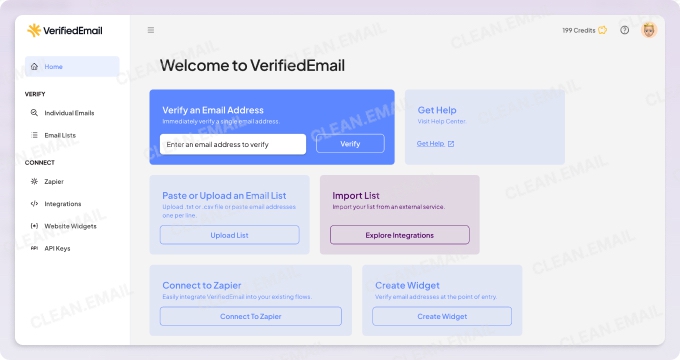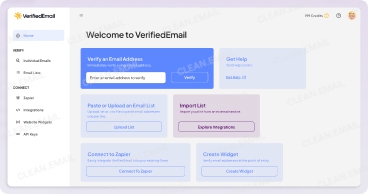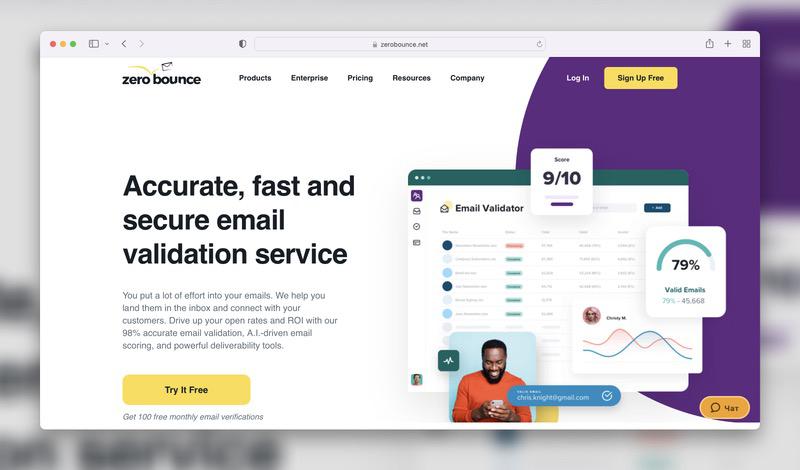What is Email Validation?
Email validation happens when addresses are verified as valid and deliverable. This means that messages can be delivered to an inbox and won’t bounce back or fail to deliver. When you verify an address list, you’ll check for typos and ensure that the addresses exist on certain domains. For example, suppose you have MSN, Yahoo, or Gmail accounts on your marketing list. In that case, the email validation service will scan those domains to make sure the address is accurate and can receive emails.
When you check if an email is valid, you can also find out if there are any potential DNS errors, typos, or server problems with the address you are checking.
How Does It Work?
In general, email service providers (ESP) are happy to offer services that validate email addresses. This includes free service providers such as Gmail and others that you might pay for. There are also free validation tools and services that allow you to test email deliverability of the addresses in your mailing lists quickly.
If your ESP doesn't offer this service, learn how to validate an email address. You can do this by installing a validity checker or use one that requires no installation and allows you to validate an address online.
Methods to Validate Email Addresses
- Send a Test Email: Directly send an email to the address to see if it bounces back, indicating invalidity.
- Use an Email Verification Tool: Employ specialized services that check the validity of email addresses without sending actual emails.
- Check for Syntax Errors: Ensure the email address follows standard formatting rules, such as the presence of "@" and a valid domain.
- Verify Domain Validity: Confirm that the domain part of the email address exists and is configured to receive emails.
- Perform SMTP Verification: Interact with the mail server to verify the existence of the recipient's mailbox without sending an email.
- Implement Real-Time Verification on Forms: Integrate validation scripts into sign-up forms to catch invalid emails at the point of entry.
These methods help maintain a clean and effective email list, enhancing deliverability and engagement.
Why is Email Validation Important?
When you run a marketing campaign or collect vital data, it’s extremely important to validate mailing lists. You want to make sure you have the proper and correct addresses for your client base. With an accurate list, you can be sure that your marketing emails will be delivered to those inboxes. This higher deliverability rate results in an increased ROI for your campaigns.
When you use tools from the best email validation service providers, you’ll protect yourself from fraudulent information that may hurt your reputation or take up space on your servers. When you validate email address lists, you’ll remove duplicate or false addresses that won’t help you carry out your marketing campaign.
If you don’t validate your mailing lists, there’s a good chance that too many messages will bounce back, which can overwhelm your servers. There’s also a chance that emails will be sent to intentionally misleading addresses. In many cases, those addresses were created by scammers and phishers who want to steal your data. Without validation, you’re giving them an easy way to access your company’s important information.
Essentially, email validation can help you improve email deliverability. A high deliverability rate enables you to carry out your marketing campaign efficiently and profitably. It also protects your company from fraud and false information.
The Types of Emails
Most email validation service providers generally look for and flag three kinds of emails.
- Valid Emails – These are existing addresses that contain no mistakes or typos. The mailboxes are functional, and the checker found no syntax issues or problems with the DNS server. Ideally, you’ll want all the addresses on your mailing lists to be valid addresses.
- Risky Emails – These addresses have been verified to exist, but there are some red flags. When you send a message to these emails, there’s a good chance it might bounce because of a server issue or other settings at the domain or user level. These addresses might also be set up for general inquiries within an organization and aren’t meant to be used for marketing purposes. Sending to these types of addresses can cause complaints about your email etiquette or might get you marked as spam.
- Invalid Emails – These addresses don’t exist. They might be invalid because of a typing error or syntax error (for example, forgetting the @ symbol or adding a symbol that can’t be used in the address). These result in a bounce and hurt your sender reputation. Sometimes these addresses existed previously but have since been deleted. This can happen on an individual level (somebody changed their name or moved to a different organization) or on a company level (the business shut down or changed their domain name).
How to Validate Email Addresses
There are a few ways how to validate email address lists on your own. The method you choose will depend on how much time you can dedicate to the validation process, your marketing budget, and the size of your list.
1. Manual Email Validation
A manual check involves looking at the address syntax, performing an IP address lookup, and checking the DNS records. These checks will tell you if the address contains the correct elements and whether it is associated with a valid domain. You’ll also find out if the domain is on a blocklist or if spammy data is associated with the domain. Manual validation can also include pinging the mail server to determine the validity of the email address.
This is the most inefficient way to validate email, especially for small businesses, because of the time and expertise involved. Also, many services offer a free trial or a free plan that provides a small number of verifications each month. These free verifications are enough for small mailing lists and marketers who are just getting started with email campaigns.
2. Use a Password Recovery Tool
Some of the popular email services, such as Gmail and Yahoo, provide their users with a way to recover a lost password. You can use these tools to check if an address exists on their servers. All you do is enter the email address, and the service displays a message telling you if the address is valid.
3. User Validation
This happens soon after someone signs up for your mailing list. They will receive a message that asks to verify their address and identity, essentially asking them to opt-in to your list. Users must respond to the message or click a link that will validate them in your system. Sometimes this results in fewer people signing up. Still, in general, it is a great way to validate an email address and ensure that your data is accurate.
4. Auto-Complete and Syntax Checker
On the sign-up portion of your website, you can add code that checks for syntax errors (like characters that aren’t allowed in addresses) and provide pull-down options for domain names so that there is no user error involved in finishing the address. This means that the user types their username before the @, but the website provides options such as Gmail, Yahoo, or MSN.
5. Third-Party Validation Tools
Many third-party programs can scan mailing lists to ensure there are no errors and that risky and invalid emails are deleted from your files. The best free email validation tool providers offer a complete lineup of checks, along with other services that help reduce the number of undeliverable emails in your mailing lists, find the addresses of people you want to make a connection with, and check thousands of addresses in bulk to reduce the amount of time you spend cleaning up your lists.
If you are looking for a popular validation service provider, you may try
VerifiedEmail. VerifiedEmail offers a highly accurate (99%) email verification tool with real-time and bulk validation options. Its robust API makes collecting and validating email addresses seamless, whether on your website or within your existing marketing platforms like Hubspot, Klaviyo, or Zapier.
VerifiedEmail also removes duplicates for free, identifies spam traps, and categorizes emails into actionable groups like "sales" and "support," streamlining your marketing efforts. With its customizable Website Widget, you can validate addresses at the point of entry, ensuring your lists stay clean from the start.


Additionally, VerifiedEmail is cost-effective, offering pay-as-you-go pricing with credits that never expire. New users can try the tool with a FREE trial of 200 credits, and applying the coupon code CLEANEMAIL10 gets you an extra 10% off. VerifiedEmail is an ideal tool for businesses that want to minimize undeliverable emails while maximizing efficiency and results.
Enter the email address using the form below and check out how VerifiedEmail works.
Another excellent choiice is ZeroBounce. This service also provides an API that makes collecting addresses a breeze. This API checks the validity of an address in real time and integrates with many popular mailing programs, such as Mailchimp, Constant Contact, or HubSpot.

Conclusion
For any business that has a focus on email marketing and distribution, it is essential that you use a strong validation tool. You need to make sure your lists are accurate so that you can improve your sender reputation. With these improvements to your mailings, you’ll reach more of your existing and potential clients. By cleaning your lists and improving your acceptance rate, you are sure to help your business grow and prevent poor scores from online services and weary customers.
How to Validate Email Address – FAQs
What does it mean to validate an email?
Validating an email means that a person or program checks to ensure that the address exists on a particular domain and that it is able to accept messages.
Which validator is used to validate the email address?
Some of the most popular email validation programs include ZeroBounce, MillionVerifier, Verifalia, VerifiedEmail, and XVerify. These programs have unique benefits and services, so it is important to do your research to find the one that will work best for your organization.
What does invalid email address format mean?
An invalid format is one that doesn’t use the correct syntax for the email. Only one @ symbol can be used in the address, and that must come before the domain name. The name can include letters, numbers, special characters (excluding @), and dots. The domain name can include all of these except for special characters. An example of a valid address is yourname12_34@xyz.com, where “xyz” is the domain that is hosting your mail address.
Why is my email not valid?
If your email is not valid, it is likely because you did not use the correct format. You may have added some invalid characters or forgotten to include the @ symbol.
How can I check if an email address is valid in Gmail?
Use the Gmail Recovery tool to determine if an address is valid. This is the same tool you’d use when you’ve forgotten your Gmail password. When you enter the email address and click Next, the tool tells you if the account is valid or not.
How do I validate an email address to send an email?
You’ll need to perform several checks. First, make sure the address uses the correct email syntax. Next, ping the mail server to make sure it is valid and perform a DNS lookup to make sure the domain is authentic. Then, perform an IP address lookup to check the authenticity of the email account.
Which method is used to check the validation of email addresses?
Most email marketers use an email validation tool to check addresses. You’ll find many validation tool providers that automatically check an email for the correct syntax and proper delivery.



